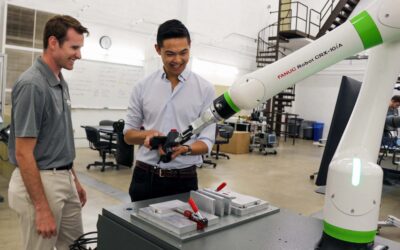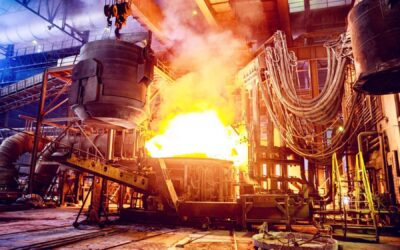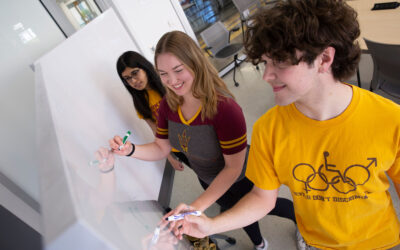Developing textured materials to ensure smooth flight
With funding from the U.S. Department of Defense, ASU researcher Gokul Pathikonda is studying novel surface textures to improve aircraft maneuverability
By Hayley Hilborn
June 16, 2023
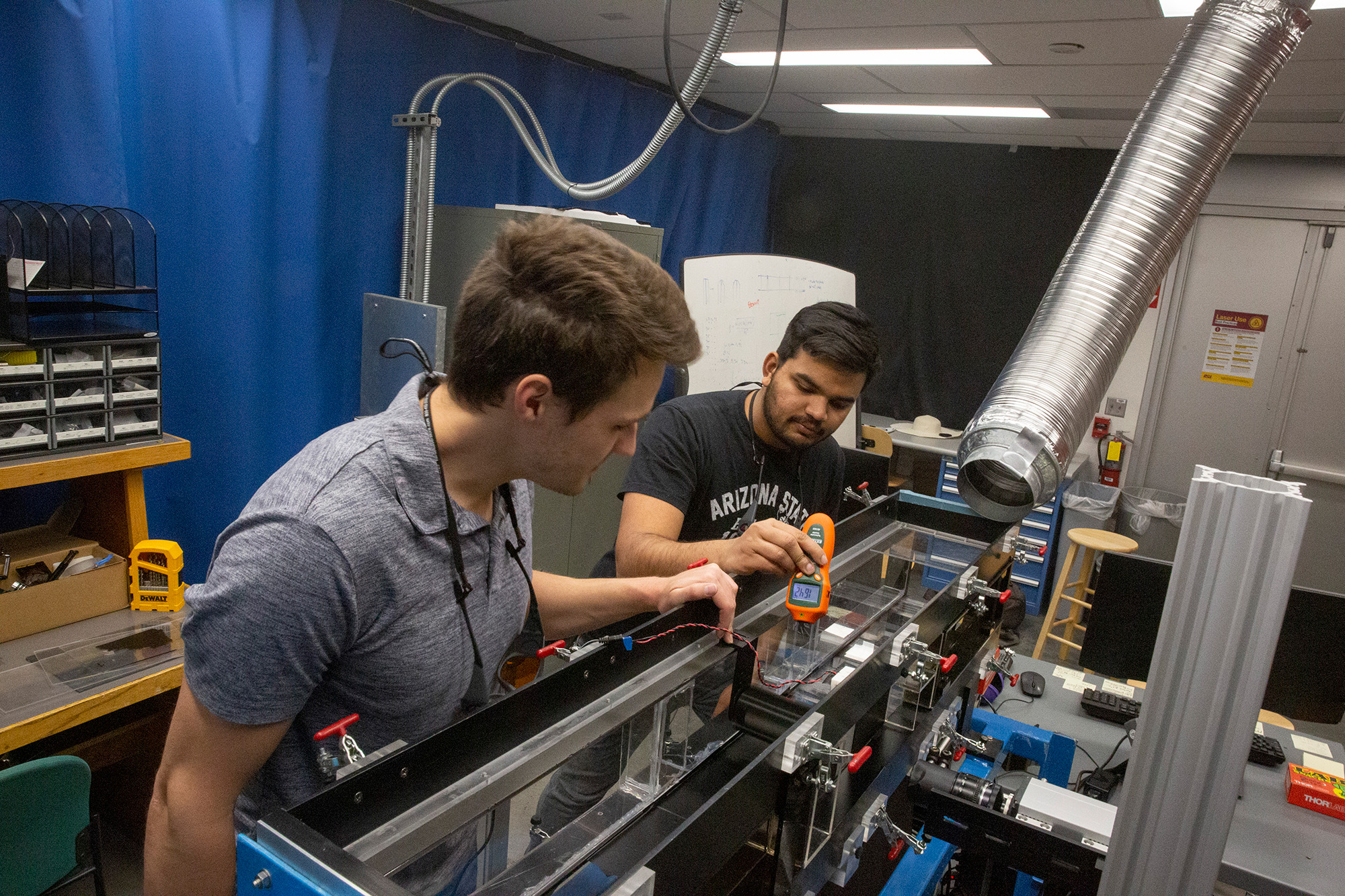
In the world of aerodynamics, the common school of thought is that the smoother the surface of an aircraft, the better it will fly. But researchers are currently challenging that assertion by developing textured materials that can improve aircraft maneuverability.
This work has earned Gokul Pathikonda attention from the U.S. Department of Defense. Pathikonda, an assistant professor of mechanical and aerospace engineering in the School for the Engineering of Matter, Transport and Energy, part of the Ira A. Fulton Schools of Engineering at Arizona State University, has been awarded a grant supported by the U.S. Air Force Office of Scientific Research, for his project titled “Understanding Vortex Turbulent Boundary Layer Interactions to Mitigate Separation Using Textured Surfaces.”
Pathikonda is collaborating with other researchers to generate new knowledge and embarking on first-of-its-kind research at ASU to explore surface textures that interact with air flow in unique ways that will benefit aircraft and other vehicles.
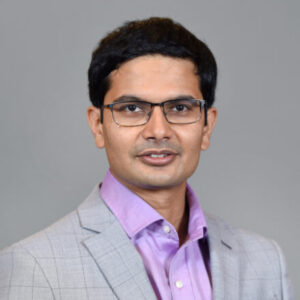
Gokul Pathikonda
This project is part of an $18 million Defense Established Program to Stimulate Competitive Research, or DEPSCoR, program awarded to 28 collaborative academic research teams across the country.
DEPSCoR is designed to strengthen the basic research infrastructure at institutions of higher education in underutilized states or territories. The DEPSCoR Research Collaboration competition, which Pathikonda applied to, helps introduce researchers to the unique research challenges and supportive research ecosystem of the Department of Defense.
The research collaboration initiative encourages participation of new faculty members to engage in impactful research by requiring that the principal investigator, or PI, for each project has never received a Department of Defense grant. It also stipulates that the PI must collaborate with a researcher who has already worked with the department who will act as a mentor and guide through the process of collaborating with the government institutions.
Vrishank Raghav, an associate professor at Auburn University will offer Pathikonda insight into how to effectively perform research for the Department of Defense, including guidance on best practices and how to interface with the department’s program officers.
Raghav’s research focuses primarily on aircraft wings, while Pathikonda experiments on surfaces. Hence, the two came together to design surfaces to control aircraft aerodynamics by developing textured materials to cover the surface of aircraft wings.
Exploring the bounds of aerodynamics
The gasses in our atmosphere behave in a specific way, which can be described as flow. Passenger planes typically remain supported by the flow in the air and maintain altitude because pilots focus on steering gently.
Ducking and diving disrupts the flow of gas molecules, rendering the flow incapable of holding the plane in the air. Highly maneuverable aircraft like fighter jets may dip and dive, necessitating overcorrection to maintain support within the air’s flow.
There are limits to how much a pilot can maneuver an aircraft before it stalls. With current designs, if an aircraft moves too erratically in a short period of time, it will lose critical contact with the air flow and abruptly lose control, requiring a skilled pilot to adjust to these adverse conditions to remain airborne.
Pathikonda’s goal is to improve wing surfaces to reduce this tendency to stall in dynamic conditions. But he says lightly texturing the material on aircraft’s wings can keep flow “attached” for longer periods of time under such conditions.
“We can find similar examples of this in nature,” Pathikonda says. “Shark skin appears very smooth, but if you actually view it under a microscope, you can see small rough elements.”
In general, rough surfaces are more problematic for aerodynamics than smooth surfaces. Pathikonda’s challenge is to engineer a texture that is a happy medium between textured and smooth.
“We cannot engineer just any texture,” he says. “We need to study how flow is being disturbed and determine how it translates to aerodynamic performance. Then we will see how I can do the texturing so that I can control performance.”
Testing textures
To evaluate the efficacy of the texture samples and ensure they do not hinder the aerodynamics of the aircraft too much, Pathikonda’s team will employ a technique called particle image velocimetry.
First, the team must place the textured material inside a wind tunnel. Then, the team activates the tunnel to observe the flow of wind and how it is disturbed close to the surface of the material.
“We use a technique called particle image velocimetry, where we use a sheet of lasers to take multiple images very close to each other,” Pathikonda says. “Then we add fog into the wind tunnel and, depending on how far the droplets in the fog travel, we can actually back-calculate how fast the wind is moving, or how much it is being disturbed close to the surface.”
In fact, most of the development for this technique was performed by ASU Emeritus Professor Ron Adrian, Pathikonda’s “academic grandfather” — meaning Adrian advised Pathikonda’s doctoral advisor.
Though Pathikonda’s team has already conducted some preliminary research using this technique and an existing wind tunnel on ASU’s Tempe campus, a larger wind tunnel is currently being constructed that will be better suited for this research and several similar future projects.
The sky isn’t the limit
The conclusions Pathikonda’s team draws from this work can be useful as a foundation for research to improve the aerodynamics of a variety of vehicles other than aircraft.
“In a sense, this surface can go on wings, a fuselage, a submarine or a ship,” he says. “I will be writing grant proposals to the Navy, and the Army as well, for helicopter aerodynamics. So, they would all be interested at some point. That’s the hope.”
Raghav works specifically with aircraft. So, when Pathikonda’s research is complete, Raghav will further contextualize it for application on aircraft wings specifically.
This partnership has been a long time in the making. While Raghav and Pathikonda attended the same undergraduate university in India, the two went their separate ways for graduate studies. The two later reconnected at a conference and realized they were both interested in aerodynamics. Hence, they combined their expertise to contribute a groundbreaking idea for basic research.
“I am very excited about this project for many reasons, but what I am most excited about is that this is the first time we’re doing research of this kind at ASU,” Pathikonda says.
“With the large wind tunnel we are constructing, we will do many other types of research, but mostly look at surface engineering or surface aerodynamics. This is the first project with this focus at ASU and the first facility of its type that’s going to be built on campus,” Pathikonda says. “So this is the kickstarter, and it’s not going to stop here. We will do more of this work.”
Related Stories
18 ASU undergraduates selected for German research fellowship
Several engineering students received the fellowship and additional funding from the Fulton Schools
Millions invested in new capabilities
Labs across ASU’s Polytechnic campus are getting an upgrade — millions of dollars in industry-grade equipment to amplify students’ career readiness
ASU to lead new DOE Clean Energy Manufacturing Innovation Institute
‘EPIXC’ seeks to eliminate industrial use of onsite fossil fuels for process heating
Students explore mental health in engineering
Fulton Schools biomedical engineering students lead research into student and professor mental health and how teaching methods affect well-being

